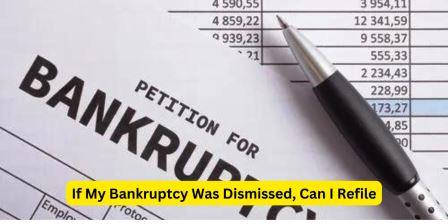So, if my bankruptcy was dismissed, can I refile? Yes, but the steps and timeline depend on the type of dismissal and whether you’ve addressed the reasons for the dismissal.
Key steps to follow if you’re considering refiling
1. Determine the Type of Dismissal
Before refiling, it’s crucial to determine whether your case was dismissed with or without prejudice. If it was dismissed without prejudice, you can usually refile immediately after resolving the issues that led to the dismissal. However, a dismissal with prejudice will require you to wait before filing again.
2. Address the Reasons for Dismissal
If your bankruptcy was dismissed due to missed payments, incomplete forms, or a court hearing absence, you need to resolve those issues. Make sure all necessary documentation is submitted on time, and any missed payments are caught up.
3. Gather Necessary Documents
When refiling, you’ll need to gather and submit updated documents, including schedules detailing your assets, debts, income, and expenses. If you’re filing under Chapter 13, you must also submit a revised repayment plan.
4. Complete Credit Counseling
Before filing for bankruptcy again, you must complete a credit counseling course. If you previously completed this course more than 180 days ago, you’ll be required to take it again.
5. File a New Bankruptcy Petition
Once you have resolved the previous issues, you can file a new bankruptcy petition. Be prepared to explain to the court how your circumstances have changed and why your new case will succeed.
Automatic Stay Rules When Refiling
One of the significant benefits of filing for bankruptcy is the automatic stay, which halts creditor actions such as wage garnishments, foreclosures, and repossessions. However, there are limitations on the automatic stay if you have had a previous case dismissed:
- First Refiling Within 12 Months: If you refile within one year of a dismissal, the automatic stay may only last for 30 days. You can request an extension, but it’s up to the court to grant it.
- Multiple Dismissals: If you’ve had two or more dismissals in the past year, you will not automatically receive the stay unless you file a motion and demonstrate significant changes in your financial situation.
Can I Refile Under a Different Chapter?
If your bankruptcy was dismissed, you may be wondering whether you can refile under a different chapter. For instance, if your Chapter 13 case was dismissed due to missed payments, you might consider refiling under Chapter 7 if you qualify.
Chapter 7 Refiling:
Chapter 7 involves liquidating non-exempt assets to pay off creditors. If your financial situation has deteriorated since the initial filing, Chapter 7 might be a better option. However, be aware that there are stricter eligibility requirements for Chapter 7.
Chapter 13 Refiling:
If you previously filed under Chapter 13, which involves creating a repayment plan, you can refile under the same chapter. This might be appropriate if you’ve made adjustments to your budget or resolved issues that caused the initial dismissal.
Seeking Legal Assistance for Refiling
If you’re still unsure whether you can refile for bankruptcy after a dismissal, consulting with a bankruptcy attorney is a wise step. An attorney can help you evaluate your financial situation, determine the best course of action, and ensure that your refiling goes smoothly.
Benefits of Hiring an Attorney:
- Legal Expertise: Bankruptcy law can be complex, and an experienced attorney will help you navigate the nuances of refiling.
- Increased Success Rate: Attorneys can guide you through the necessary steps and help avoid the mistakes that led to your initial dismissal.
- Representation: An attorney can represent you in court and negotiate with creditors on your behalf.
See Also- Free Foreclosure Lawyers: A Guide to Navigating Financial Hardship
Key Takeaways for Refiling Bankruptcy After a Dismissal
- If your bankruptcy was dismissed without prejudice, you can refile immediately after correcting the issues that led to dismissal.
- A dismissal with prejudice typically requires a 180-day waiting period and may come with additional restrictions.
- Refiling for bankruptcy may involve gathering updated documents, completing credit counseling, and submitting a new petition.
- The automatic stay may be limited if you’ve had previous cases dismissed within the last year.
- Consulting with a bankruptcy attorney can increase your chances of a successful refiling.
FAQs on Refiling Bankruptcy After a Dismissal
- Can I refile for bankruptcy if my case was dismissed? Yes, you can refile after addressing the issues that led to your dismissal.
- Do I have to wait to refile after a dismissal? If your case was dismissed with prejudice, you must wait 180 days before refiling.
- Can I refile under a different chapter? Yes, depending on your financial situation, you can refile under a different chapter, such as switching from Chapter 13 to Chapter 7.
- Will the automatic stay apply if I refile? The automatic stay may be limited if you refile within a year of a dismissal.
- Should I consult an attorney before refiling? Yes, it’s highly recommended to seek legal advice to improve your chances of success.

There is definately a lot to find out about this subject. I like all the points you made
I’m often to blogging and i really appreciate your content. The article has actually peaks my interest. I’m going to bookmark your web site and maintain checking for brand spanking new information.